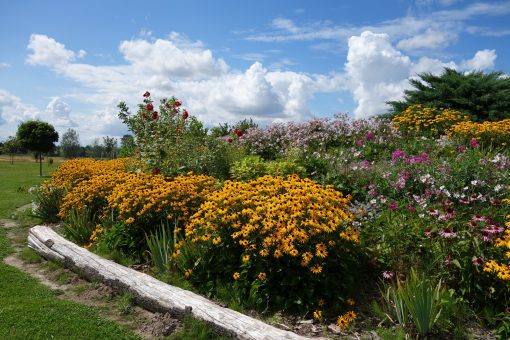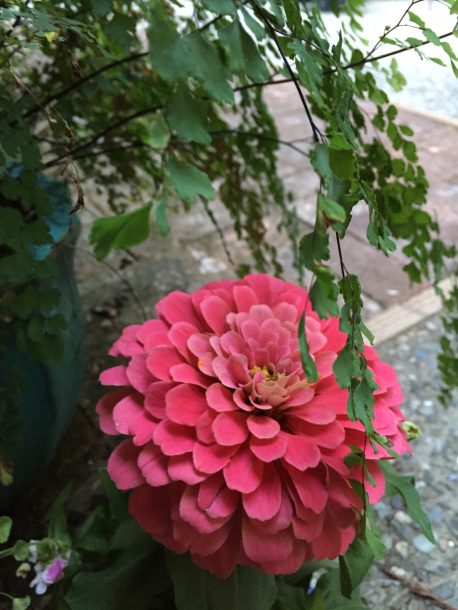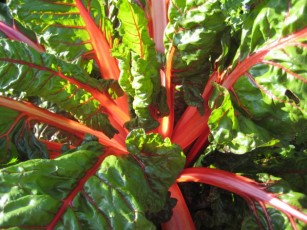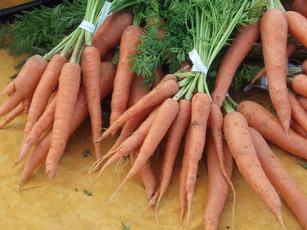
Now that you’ve treated yourself to a few new un-thirsty perennials that bloom late in the season it’s time to start working on that list of early fall gardens chores. Here are some that might apply to your own garden.
Spider mites are especially prolific during hot, dry weather. Sometimes you don’t even know how bad the infestation is until all your leaves are pale with stippling. Periodically rinse dust and dirt off leaves with water. Spray the infected leaves with organics like insecticidal soap switching to neem oil if they build up a resistance to one of the pesticides.
Plant cool season veggie starts like broccoli, cabbage, cauliflower, chard, lettuce, spinach, brussels sprouts, onions and leeks in soil enriched with 4-6 inches of compost as summer vegetable crops will have used up much of your soil’s nutrients.
You can sow seeds of beets, carrots, radishes, spinach, arugula, mustard and peas directly in the ground.
If you aren’t going to grow vegetables in the garden this fall consider planting a cover crop like crimson clover after you’ve harvested your summer vegetables.
Another thing to do while out in the garden this month is to cut back berries vines that have produced fruit. Canes of the current season should be trained in their place.
This is also the time to start perennial flowers seeds so that they’ll be mature enough to bloom next year. Now through October, divide summer blooming perennials like agapanthus, coreopsis, daylily and penstemon that are overgrown and not flowering well. You can also divide spring blooming perennials like candytuft, columbine, astilbe, bergenia and bleeding heart but sometimes they don’t bloom the first spring afterwards due to the energy they use re-establishing themselves.

Deadhead flowering annuals and perennials as often as you possibly can. Annuals like zinnias and cosmos will stop blooming if you allow them to go to seed. The same is true of repeat blooming perennials like dahlia, scabiosa, echinacea and lantana. Santa Barbara daisies will bloom late into winter if cut back now.
Fertilize shrubs lightly one last time if you haven’t already done so last month. All shrubs, especially broad-leaved evergreens such as rhododendron, pieris, camellia, hebe, need to calm down, stop growing and harden off to get ready for the winter cold. Some plants have already set next year’s buds.
Roses especially appreciate a bit of fertilizer now, encouraging them to bloom another round in October. To keep them blooming make a habit of pinching and pruning off old flowers. Always cut back to an outward facing branchlet with five leaves. There are hormones there that will cause a new rose to grow much sooner than if you cut to one with only three leaves. You can always cut lower on the stem if you need to control height.
One last to do: Make a journal entry celebrating the best things about your garden this year.



 ur house like houseplants. It’s similar to sprouting alfalfa, cress, sunflower and buckwheat seeds in a jar and eating them before the second set of leaves emerge. Micro greens, however, can be grown in soil, sprinkled on sponges or fine textured fabric. Because they won’t be around long enough to flower or fruit, they don’t need much light. . It takes about 30 days for micro greens to set their first leaves and be ready to harvest. When the first leaves appear they are at the peak of their nutritional concentration.
ur house like houseplants. It’s similar to sprouting alfalfa, cress, sunflower and buckwheat seeds in a jar and eating them before the second set of leaves emerge. Micro greens, however, can be grown in soil, sprinkled on sponges or fine textured fabric. Because they won’t be around long enough to flower or fruit, they don’t need much light. . It takes about 30 days for micro greens to set their first leaves and be ready to harvest. When the first leaves appear they are at the peak of their nutritional concentration.